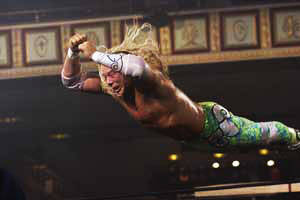Since President Obama’s inauguration, commentators have parsed each line of his address and concluded that it somehow lacked the inspirational power of John F. Kennedy’s. They are probably right. As a young man I was certainly inspired to hear that “the torch has been passed to a new generation”—that is, to mine. Forty-eight years later, I wonder about “my” generation as it listened to Obama’s words and realized that the torch had passed from its hands to somebody else’s. How does it feel to learn that the bulk of one’s biography is now written in the past tense? The future tense can be used only for the few concluding chapters and an epilogue.
The Wrestler provides a similar meditation on mortality, set in the improbable world of seedy sports arenas, strip bars, a shabby seaside resort and a trailer park. Randy “the Ram” Robinson (Mickey Rourke), a professional wrestler, has begun to experience the universal law of entropy. Like all things mortal, he faces the start of a long downward trajectory, and like all things human, he may be the last to recognize the fact, or admit to it. His tragedy comes not from the realities of the life cycle, which can be ennobling or even triumphant in its later stages, but from his inability to reinvent himself, physically or spiritually, to embrace his changing universe. He inhabits a world of strong, resilient bodies, even as his own begins to crumble. He discovers that his once-imposing physique masks a terrible emptiness within. Yet in the rare moments when he realizes the truth, he can’t do anything about it.
Rather than slow the narrative by filling in the back story, Darren Aronofsky, the young director, opens with a camera slowly panning across a collage of wrestling posters, as the soundtrack offers a series of ringside announcements from major arenas and championship matches from the 1980s. This was the golden time for the Ram, but as the film opens in present time, the posters have begun to fade and the voices have become muffled through the curtains of years. In near darkness, the camera reveals shadowy glimpses of the Ram as he prepares for yet another exhibition. His full face finally appears like an indecent thing we have come upon and prefer not to have seen. The face is bloated with steroids and deformed by scar tissue. At age 52, Mickey Rourke has the face of a man who has taken the worst that life can dish out and, although he is losing, is determined to come out for the final rounds.
The Ram’s journey has taken him from headlining a card at Madison Square Garden to an American Legion post in suburban New Jersey, where the noise of the makeshift plywood ring adds to the entertainment for the 50 or so fans who come. At least a few did come. Maybe it will be better in Utica or Wilmington. After the match, he drives his van to his home in a trailer park, only to find the door sealed by the landlord until he pays back rent. He pleads to be allowed in to get an ice pack for his injured back, but without success. Fresh from his victory in a meaningless but painful match, he is forced to sleep in the van.
The fan base for live wrestling is dwindling steadily in the age of cable television extravaganzas. He and several other wrestlers drive up to Rahway, N.J., to stir up publicity for a forthcoming exhibition. They sit at folding tables in an empty room, waiting to sign programs and posters for the fans who never come. A few children wander in to have their pictures taken with the battered celebrities.
The Ram seems comfortable with the youngsters, since in many ways, despite his hulking body, he is a child himself. In a poignant scene that captures the extent of his loneliness, he invites a boy of about 10 to come into his trailer to play video games with him. The boy soon grows bored and prepares to leave, but the Ram pleads with him to stay. Current awareness of the sexual abuse of children initially makes us uncomfortable with the situation, but as the scene develops the discomfort switches from apprehension about the boy’s safety to a palpable sadness at the pathetic loneliness of a grown man’s needing a child to stay with him for just a few more minutes.
The Ram seems most at home in the locker room surrounded by younger wrestlers. He adopts a fatherly role in encouraging an up-and-coming star to keep working on his routine. The conversation is touching, even as it opens a window into their bizarre world. The Ram is fresh from a stint in a beauty salon to have his shoulder-length blond hair tinted and from a visit to a tanning parlor to work on his California complexion. The younger man wears a heavy chain dog collar and a spiky Mohawk crest across his partially shaved scalp. Yet the two cartoonish characters converse with utmost seriousness, like father and son, with the older man dispensing advice and the younger listening respectfully. Their primary responsibility, they agree, is entertaining the fans, and the young man has a talent for that. Competition has nothing to do with their profession; they choreograph the steps that will lead to a predetermined outcome.
Darren Aronofsky and Robert D. Siegel, the screenwriter, underline the show-business side of wrestling by drawing a parallel to the sex industry. Cassidy (Marisa Tomei) dances in the Ram’s favorite strip bar. Both the Ram and Cassidy use and abuse their bodies to entertain customers. They create fantasy worlds for a few dollars. They both adopt alien identities and bogus names: his name is Robin, hers Pam. She supports a son with a job she despises; he has a daughter he has not seen in years. Their real identities remain hidden under the tissue of illusion they create around themselves.
As the story develops, both have reason to question whether they should find another line of work. In his terrible loneliness, the Ram deludes himself into thinking that his relationship with Cassidy consists of more than that of a paying customer to an entertainer. They have instances of genuine communication, and Cassidy briefly lets herself believe he is more than a client. In the same way, the Ram’s estranged daughter, Stephanie (Evan Rachel Wood), tries to believe that she and her father can be reconciled, but her acceptance depends on his being able to change. This brief subplot leaves too many loose ends to be completely convincing, but it shows the Ram’s nearly frantic attempt to establish a relationship with another human being.
A heart attack and invasive bypass surgery force the issue. The Ram announces his retirement from the ring and plans a new life: no more steroids and illegal painkillers, no more pain-filled exhibitions of brutality to please the fans. Yet without skills or connections outside the wrestling circuit, what can he do? He takes an entry-level job as a counterman in the deli section of a supermarket where his odious supervisor (Judah Friedlander) seems determined to humiliate him. While the experiment in building a new life teeters on the edge of success, since his showmanship adds flair to his dealing with the customers, it eventually becomes clear that the Ram is a wrestler, nothing more, nothing less. He will not spend the rest of his life slicing bologna or spooning out potato salad.
Randy “the Ram” Robinson got his nickname from his signature move in the ring: whenever his stunned opponent would lie helpless on the mat, the Ram would climb to the top rope over the corner post and stand upright over his adversary and the crowd. Then he would leap toward the ring lights, soar weightless for an instant and crash down upon the other man. He became a living ram, crushing all resistance. His fans loved it and waited for it in every match. This is a perfect image of his life: he soars, the crowd cheers, then he plunges downward to destroy his enemy. Outside the ring, however, his moment of glory ends in a crash that leaves his own life a pile of twisted wreckage.
From the archives, Richard Blake, S.J., reviews Mickey Rourke in "Diner."








